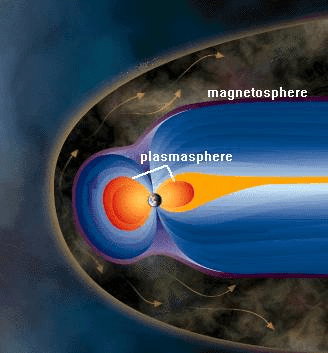“There is a tide in the affairs of men,” Shakespeare had Brutus say. The Bard was speaking metaphorically, but it turns out there are far more real tides than he knew, with the latest being found in the cold plasma that surrounds the Earth in a giant donut shape above the atmosphere.
Shakespeare didn’t even know tides were caused by the Moon, let alone that the Earth’s crust and atmosphere both bulge slightly in time with the ocean. Nor was he aware that the Earth is surrounded by a region of disassociated protons and electrons, but perhaps he wouldn’t have been surprised to learn that it too has a tide.
This fact has been revealed in a new paper using forty years of data taken by satellites that can observe the plasmasphere’s boundary layer. However, it turns out the plasmasphere’s cycle is not the same as that observed for other parts of the Earth.
The plasmasphere is a region of magnetized plasma that follows geomagnetic field lines upwards from the ionosphere, from which the plasma rises during daylight, before collapsing back at night.

The plasmasphere is known to bulge during daylight and shrink at night, but what this image doesn’t capture is the Moon also shapes its height. Image Credit: NASA
Although Dr Chao Xiao of Shandong University and co-authors found a clear pattern in the satellite data of the plasmasphere, they explain in their paper that “The signal possesses distinct diurnal (and monthly) periodicities, which are different from the semidiurnal (and semimonthly) variations dominant in the previously observed lunar tide effects in other regions.”
Using satellite measurements of the plasmapause – the plasmasphere’s outer boundary – from 1977 to 2015, the paper finds that the tides can be hard to detect during periods of high solar activity. However, when such interference is low, clear patterns could be observed based on the location and phase of the Moon. The high tide runs about six hours ahead of the Moon being overhead, in contrast to tides in liquids, solids, or gas.
The authors attribute these effects to disturbances in the Earth’s radial electric field, although they are not sure of the causal link.
As the paper notes, the tides can be important for more than sailing. Leaving aside the question of whether we are finally ready to draw significant amounts of power from the oceans’ half-daily rise and fall, crustal tides can cause earthquakes and volcanic activity.
“The ocean tide can influence the flow of heat from equatorial to polar regions,” the paper notes, and the intertidal zone may be the reason life made it out of the oceans at all.
“Atmospheric tides have a global impact on rainfall,” the paper adds, suggesting that maybe tides in plasma could matter too in some way we have yet to determine.
In addition to any Earthly consequences, plasmas are common in space, and the knowledge that astronomical bodies can induce tides in them could be useful for modeling their behaviors in many other circumstances.
The paper is published open access in Nature Physics.
[H/T LiveScience]
Source Link: Even The Earth’s Magnetic Field Has Moon-Driven Tides